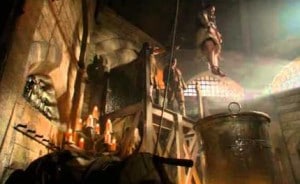
On 5th April 1531, Richard Roose (or Rouse), the cook in the household of John Fisher, Bishop of Rochester, was boiled to death after being attainted of high treason. It was claimed that Roose had poisoned a porridge (or pottage)* served to Fisher and his guests on 18th February 1531. All who ate the porridge became ill, and two people died. Bennett Curwen and Alice Tryppytt, who died, had not been guests at the meal but had been fed the remains of the porridge when they had called requesting alms.
Roose claimed that he had put purgatives in the food “as a jest” and had not meant to harm anyone, but Henry VIII persuaded Parliament to pass a bill, the Acte for Poysoning (22 Henry VIII c.9), which attainted Roose of high treason and made it high treason to kill anyone by poison. William Stacy1 and K. J. Kesselring2 both write of how Eustace Chapuys, the Imperial ambassador, believed that Henry VIII became personally involved in this case and wanted Roose dealt with in this manner because he wanted “to avert suspicion from falling, if not on himself, for he is too noble-minded to have resource to such means — at least on the Lady and her father”, after all, Bishop Fisher was proving to be a thorn in the Boleyns’ side with his opposition to an annulment of Henry VIII’s marriage to Catherine of Aragon.3 There is, of course, no evidence that the King or the Boleyns were involved in the poisoning.
William Stacy believes that the text of the 1531 act points to the act being implemented because of “the heinousness of the crime”, rather than it being anything to do with Fisher being the victim or public suspicion of the involvement of the Boleyns, and that the punishment, which served as a re-enactment of the crime, would deter future poisoners.4 Kesselring notes that the draft bill proposed “to attaint the cook only of voluntary murder”, not treason, and that “the decision to label the offence treason, one suspects, emerged from the King’s desire to bar the benefit of clergy to subsequent offenders.”Kesselring is of the opinion that the act was “an expedient means of extending punishment, and denying clerical immunity, for a particularly dramatic crime.”5
Richard Roose was taken to Smithfield on 5th April 1531 and boiled to death. It would have been a slow and painful death. He was not the only person to be punished in this manner as a result of the 1531 act, Margaret Davies was boiled to death on 17th March 1542 at Smithfield for poisoning “3 households that she dwelled in”.6
*Chapuys referred to the dish as soup or pottage, the 1531 Poison Act referred to it as pottage made with poisoned yeast, and Stacy and Kesselring both refer to it as porridge.
Notes and Sources
- Stacy, William R. (1986) Richard Roose and the Use of Parliamentary Attainder in the Reign of Henry VIII, The Historical Journal, 29, I, p1-15
- Kesselring, K.J. (September 2001) A Draft of the 1531 ‘Acte for Poysoning’, The English Historical Review Vol. 116, No. 468, pp. 894–899
- Calendar of State Papers, Spain, Volume 4 Part 2: 1531-1533, 646
- Stacey, p4-5
- Kesselring, p896
- Wriothesley, Charles (1875) A chronicle of England during the reigns of the Tudors, from A.D. 1485 to 1559, p134-135